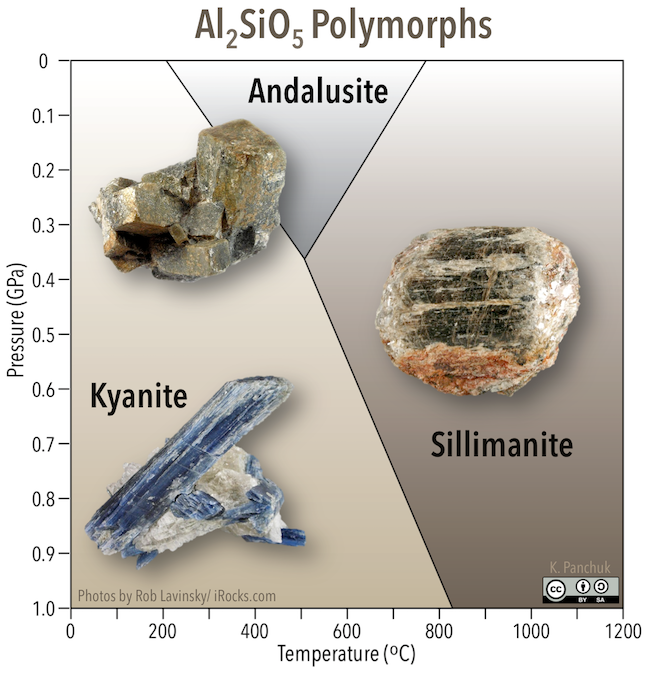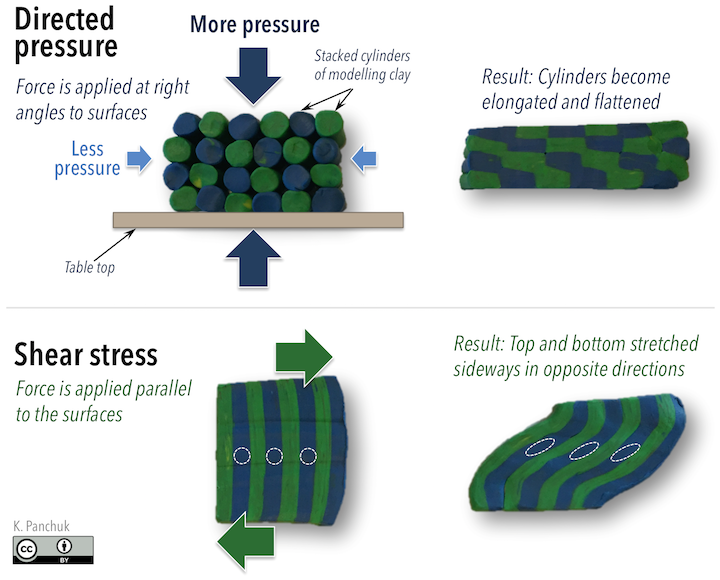55 10.1 Controls on Metamorphic Processes
The main factors that control metamorphic processes are:
- The chemical composition of the parent rock
- The temperature at which metamorphism takes place
- The pressure applied, and whether the pressure is equal in all directions or not
- The amount and type of fluid (mostly water) that is present during metamorphism
- The amount of time over which metamorphic conditions are sustained
Mineral composition
Parent rocks can be from any of the three rock types: sedimentary, igneous, or metamorphic. The critical feature of the parent rock is its mineral composition. This is because the stability of minerals—how they are influenced by changing conditions—is what determines which minerals form as metamorphism takes place. When a rock is subjected to increased temperatures and pressures, some minerals will undergo chemical reactions and turn into new minerals, while others might just change their size and shape.
Temperature
Temperature is a key variable in determining which metamorphic reactions happen because minerals are stable over a specific range of temperatures (dependent on pressure and the presence of fluids). Quartz, for example, is stable from surface temperatures up to approximately 1800°C. Under higher pressures, that upper limit will also be higher. If water is present, the limit will be lower. Most other common minerals have upper limits between 150°C and 1000°C.
Some minerals will change their crystal structure depending on the temperature and pressure. Quartz has different polymorphs that are stable between 0°C and 1800°C, but the differences in quartz polymorphs aren’t nearly as stunning as with the minerals kyanite, andalusite, and sillimanite. They are polymorphs with the composition Al2SiO5. These polymorphs are especially useful for studying metamorphic rocks, because their presence can be used to figure out what pressures and temperatures a metamorphic rock experienced (Figure 10.3). If a rock has more than one of these polymorphs, the pressure and temperature range can be narrowed down even further to the boundaries of the stability fields.

Pressure
Pressure has implications for mineral stability, and therefore the mineral content of metamorphic rocks, but it also determines the texture of metamorphic rocks.
When directed pressure (or directed stress) acts on a rock, it means the stress on the rock is greater in one direction than another. In an experiment with cylinders of modeling clay stacked in a block (Figure 10.4, top), pushing down on the clay from above resulted in higher directed pressure in the up-down direction (larger arrows; downward from pushing on the clay, and upward from the force of the table beneath the clay) than in the sideways direction, where only air pressure was acting (small arrows). The clay cylinders became elongated in the direction of least pressure.

Rocks undergo shear stress when forces act parallel to surfaces. In another modelling-clay experiment, applying oppositely directed forces to the top and bottom of a block of clay (Figure 10.4, bottom) caused diagonal stretching within the block. Note the change in shape of the dashed white reference circles.
In both experiments, parts of the clay became elongated in a particular direction. When mineral grains within a rock become aligned like this, it produces a fabric called foliation. Foliation is described in more detail later in this chapter.
Dance Break!
Fluids
Water is the main fluid present within rocks of the crust, and the only one considered here. The presence of water is important for two main reasons. First, water facilitates the transfer of ions between minerals and within minerals, and therefore can speed up metamorphic chemical reactions. Not only can metamorphism happen more rapidly, but processes can be completed that might not otherwise have time to occur.
Secondly, water—especially hot water—can have elevated concentrations of dissolved substances, making it an important medium for moving ions from one place to another within the crust. Processes facilitated by hot water are called hydrothermal processes (hydro refers to water, and thermal refers to heat).
Time
Most metamorphic reactions are slow. It’s estimated that when new minerals grow in a rock during metamorphism, they add about 1 mm to the outside of the mineral crystal for every million years. Very slow reaction rates make it hard to study metamorphic processes in a lab.
While the rate of metamorphism is slow, the tectonic processes that lead to metamorphism are also very slow, so there is a good chance that metamorphic reactions will be completed. For example, an important setting for metamorphism is many kilometres deep within the roots of mountain ranges. A mountain range takes tens of millions of years to form, and tens of millions of years more to be eroded to the extent that we can see the rocks that were metamorphosed deep beneath it.
How Old Is This Rock?

